Cook Buddy
This project aims to provide college students with possible solutions to cooking together in order to expand social lives and explore healthier lifestyles.
Role:
UX Researcher
UX Designer
Team:
Jiadong Chen
Jialun Sun
Yiding Ma
Tool:
Figma
Google CSCW system
Introduction
Motivation
Save Money: “On average, it is almost five times more expensive to order delivery from a restaurant than it is to cook at home” (Forbes)
Health and Nutrition: “When people cook most of their meals at home, they consume fewer carbohydrates, less sugar, and less fat than those who cook less or not at all”(JHU)
Reduce Food Waste: Helping people use all the food or raw materials they bring home and thus reducing waste.
Social Connection Benefits: “When people are socially connected and have stable and supportive relationships, they are more likely to make healthy choices and to have better mental and physical health outcomes” (CDC)
Goal
-
Help college students enrich their social lives through cooking with other people
-
Help college students save food and money
-
Understand what people care about and concern regarding cooking especially with other people.
Research
Methods
Contextual Inquiry
We used convenience sampling to recruit 6 graduate students at the University of Michigan. They are all from the 22 - 25 age range and 4 of them are female, and 2 are males. Some of them are related or referred in order to meet research requirements. They are formed into 3 groups, one group of friends who had never cooked together, and two groups of students who had cooked together before. The limitation of this recruitment is the lack of strangers as one group so we cannot observe how strangers might act differently with friends who have never cooked together before. However, we assume people will at least know something about the other ones if they want to have a potluck. This limitation will have a moderate impact on our observation.
Survey
Given our project's focus on college students, we developed a survey and distributed it across student groups on platforms like Slack, Discord, and WeChat. To ensure the relevance of our data, we included a preliminary question confirming the respondent's college student status. Those answering 'no' were automatically directed to the survey's end, as they fall outside our target demographic. Moreover, since our survey predominantly concentrated on potluck experiences, we sought to ensure that the collected responses originated from individuals who had previously participated in such events. Consequently, out of the 56 responses obtained from college students at UM, we discovered that 6 respondents had never engaged in cooking with others. Accordingly, we excluded the responses from these individuals from our survey analysis.
Interview
The interview recruitment is done through sub-questions in the survey. The respondents who left their email addresses at the end of the survey are our potential volunteers. We asked each of the participants about their potluck frequency. As a result, we picked the 6 most experienced interviewees from a group of 10 volunteers.
Findings
Contextual Inquiry
Potluck preparations:
Teams with prior experience working together tend to favor task distribution before embarking on the cooking process. A common thread among these groups is the presence of at least one individual who is often more experienced in cooking, serving as a pivotal member of the team.
Communication:
Teams with a history of collaboration exhibit less discussion regarding the culinary process itself.
Conversely, a pair of friends who are navigating their first cooking endeavor together find themselves deeply engaged in conversation about the dish's procedures and operations.
Meanwhile, seasoned chefs prioritize efficiency, allowing their discussions to drift to unrelated subjects, showcasing a more relaxed approach to the collaborative cooking experience.
Body language:
Mixed-gender teams tend to maintain a larger personal space between members, even in constrained kitchen environments.
Pairs of female friends embarking on their first cooking project together exhibit closer physical proximity, learning and taking turns at each step of making a cake, with one observing the other intently when not actively engaged in a task.
Survey Findings
Locations:
When it comes to where people like to cook for potluck parties, they mostly prefer cooking in their own kitchens. If not their own, then they'd rather cook at a friend's place than rent a commercial kitchen. What's most important to them is knowing their way around the kitchen and having enough room to cook comfortably.
Weighted Ranking(preference): Your Own Kitchen > Friend’s Kitchen > Rent Commercial Kitchen

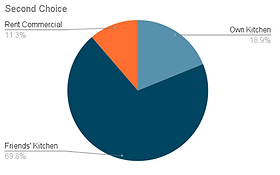

Driven for potluck / cooking
People join potluck events mainly because they find them fun, they get to try different kinds of food, and it's a great way to meet and hang out with people. It helps if they know someone there; it makes them feel more at ease.
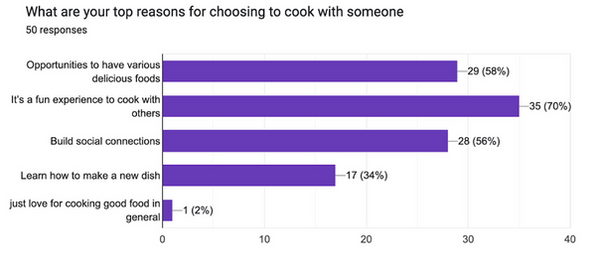
Challenges / Problems
But joining a potluck can have its problems. Sometimes, there's just not enough space in the kitchen. If it's not their kitchen, they might not know where things are or how to use the kitchen tools. Cleaning up after everything can also be a hassle.

Attitudes towards cooking with others
As for cooking with people they don't know, people are okay with it, but not super excited. The scores show that on average, people are somewhat open to the idea but might have some reservations. It means they're willing to give it a try but would probably feel more comfortable if they knew some of the people there.vvvvvvvvvvvvvvvvvvvvvvvvvvvvvvvvvvvvvvvvvvvvvvvvvvv
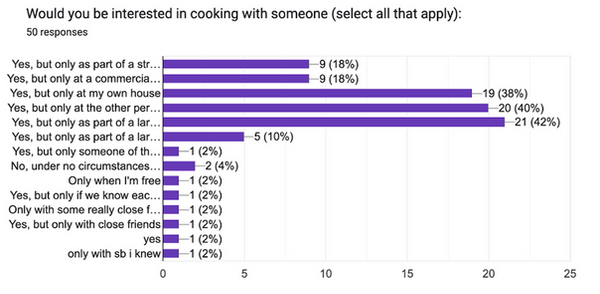

Interview Findings







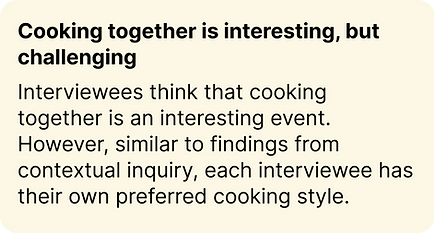
Design Requirements
Based on the research results, we concluded 4 major demands for potential users to organize a potluck conveniently and easily. The ultimate goal of the design is to support the users to conduct project management successfully through our design.
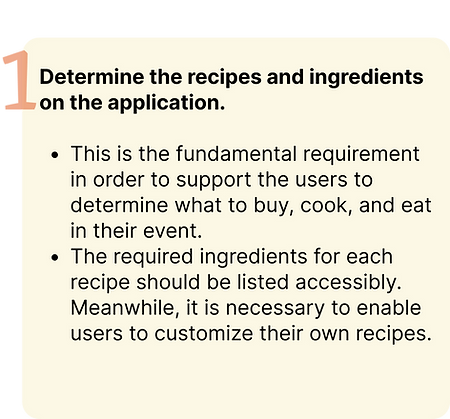



User Flow

Design Details
Overview
After 4 weeks of user researching, we finally reach to the design status. However, our team was challenged by lack of enough human resources. While other teams have 4-5 members, we only have 3 people. Therefore, we priortized the functionalities and our goal was to launch the prototype with the must-have functions.


The Low Fidelity Prototypes


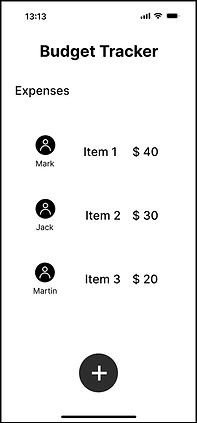

Evaluation
Evaluation Plan
The evaluation plan was conducted twice. The first time was to evaluate the usability of Lo-Mid Fidelity prototype. The second one was to evaluate High fidelity.

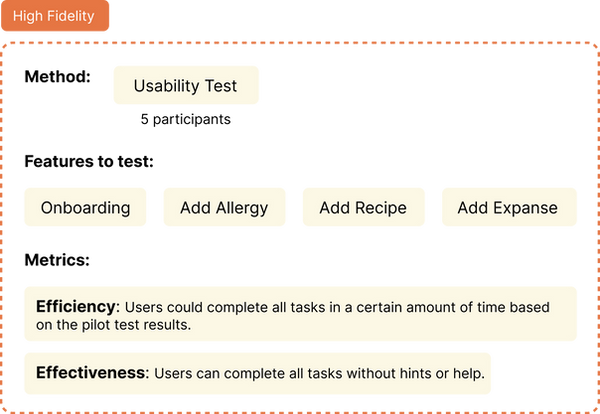
Evaluation Findings and Iteration
Preference Test - Top Navigator Bar

“the color of other options is way too dominant. I don't want the navigation bar to capture my eyes. ”
Preference Test - Ingredient cards
The preference test were used on let testee chosing their favorite elements. Because we were lack of time, we could not compare every elements individually. Therefore, when doing testing, we also made the testees to indicates what's their favorite and least favorite elements, so we can choose those most favorited by testees.

Both choice C were selected as the most favorite designs. The result helped us to set the design tone to be as simple as possible.
Usability Test
Allergic Food
"What if I am allergic to some food, do I need to tell others individually?"
Inspired by this feedback, we realized that our research process did not include people who have different diet. therefore, in final design, users could add their food preferences during the onboarding process.


Invisible function
Testees indicated that the chat function was not visible enough to be accessed. Hence, we tried to make the chat function as a belonging to the event function

Overwhelming Process
Based on our research result, requesting for certain ingredients was a basic demand for potential users. But in our original version of design, this function was reported as "Confusing and overwhelming." Hence, we redesigned the whole process in order to fulfill users' essential and significant demands.

Final Designs
The following is the whole interactive final prototypes
Reflection
Technical
Technical implementation for the design is not too difficult. Development for IOS and Android would be necessary to support more users. There are some possible ways to develop the application to be even more supportive. For example, Generative AI would be an effective supplement to enhance the user experience dramatically. Right now, designing recipes is still a workload for users. When the participants of one event increase, recipe selection would become increasingly complex due to individuals’ preferences. Generative AI could help users to figure out what to eat based on their profiles. Meanwhile, the cooking process could be recommended and modified.
Logistic
When the application is developed successfully, our team still needs to hire experts of marketing in order to involve more users. In order to become profitable, the application could cooperate with supermarkets and delivery service providers. Furthermore, the application could include more stakeholders than college students alone. In order to expand the target user group, more user research is required to understand other possible users’ preferences.
Further Research
In our design requirement phase, we have considered commercial kitchens and holding cooking events to help people using cooking as a social tool. Even though the commercial kitchen is not welcomed based on our research, the cooking event could be the next step. The participants have indicated that they are willing to cook with friends’ friends. Therefore, we want to explore the opportunities to make the application with more social functionalities. Meanwhile, as stated in previously, user research for a broader user group is needed to expand more profitable opportunities. Hopefully we could expand the user ages from 18 to approximately 30 years old. Moreover, in our user research, the difficulty of the cooking process is not studied comprehensively, and the corresponding challenges are not solved. Hence, this could be an aspect in order to expand the functionality of our design.
Conclusion
Our design could support the target users’ demand for preparing cooking together. With our design, the target users could organize an event and invite friends to cook together easily. Future development could be centralized on using generative AI to produce a more automatic, customized solution. Meanwhile, the difficulty of cooking could be considered in the next step. Right now, people who are not familiar with cooking are not supported enough by our application.
This was the last project I designed in my master degree. I am glad that I could worked with my teammates, who are also my lifetime friends. During the whole process, because of paucity of human resources, we needed to learn how to make compromise between our ideas and time limitation. Ultimately, we launched a version that we are all proud of. If it is possible, I would love to continue this project and launch the reall app.